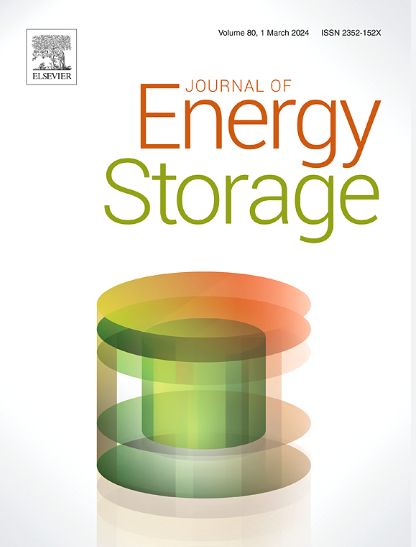用高岭土纳米管/聚多巴胺构建无枝晶耐用锌金属阳极鲁棒快速脱溶界面层
IF 8.9
2区 工程技术
Q1 ENERGY & FUELS
引用次数: 0
摘要
金属锌被认为是一种很有前途的水性锌基电池(azb)阳极候选者,然而,枝晶形成和寄生副反应等问题严重影响了其可逆性和实际寿命。在本研究中,我们在锌箔表面构建了一个由高岭土纳米管和聚多巴胺(HNTs/PDA)组成的坚固、快速脱溶界面层,以实现无枝晶和耐用的锌阳极。PDA中的氨基和羟基促进了Zn(H2O)62+的脱溶过程,使Zn2+通量均匀分散,而HNTs外表面带负电的硅氧烷基团起到离子筛的作用,使Zn2+通量分布均匀,减轻了浓度极化。此外,带正电的铝羟基和HNTs的空心管结构通过静电吸附有效地捕获了SO42 -和OH -,从而抑制了副反应。因此,基于HNTs/PDA@Zn的对称电池可以在1ma cm - 2下稳定循环2000小时以上,容量为1mah cm - 2,表现出优异的循环性能。当与V2O5阴极配对时,HNTs/PDA@Zn||V2O5全电池提供高放电容量和长周期稳定性,在5.0 a g−1下超过1800次循环而不会显着降低性能。本文章由计算机程序翻译,如有差异,请以英文原文为准。
Constructing robust and fast desolvation interfacial layer with halloysite nanotubes/polydopamine for dendrite-free and durable zinc metal anode
Metallic zinc is recognized as a promising anode candidate for aqueous zinc-based batteries (AZBs), however, issues such as dendrite formation and parasitic side reactions severely deteriorate its reversibility and practical lifespan. In this study, we construct a robust and fast desolvation interfacial layer composed of halloysite nanotubes and polydopamine (HNTs/PDA) on the surface of Zn foil to achieve dendrite-free and durable Zn anodes. The amino and hydroxyl groups in PDA promote the desolvation process of Zn(H2O)62+, resulting in a uniform dispersion of Zn2+ flux, while the negatively charged siloxane groups on the outer surface of HNTs function as an ion sieve, homogenizing the Zn2+ flux distribution and alleviating concentration polarization. Additionally, the positively charged aluminum hydroxyl groups and hollow tubular structure of HNTs effectively trap SO42− and OH− through electrostatic adsorption, thereby suppressing side reactions. Consequently, the symmetric cell based on HNTs/PDA@Zn can be stably cycled for over 2000 h at 1 mA cm−2 with a capacity of 1 mAh cm−2, demonstrating excellent cycling performance. When paired with a V2O5 cathode, the HNTs/PDA@Zn||V2O5 full cell delivers high discharge capacity and long cycle stability without significant performance deterioration over 1800 cycles at 5.0 A g−1.
求助全文
通过发布文献求助,成功后即可免费获取论文全文。
去求助
来源期刊

Journal of energy storage
Energy-Renewable Energy, Sustainability and the Environment
CiteScore
11.80
自引率
24.50%
发文量
2262
审稿时长
69 days
期刊介绍:
Journal of energy storage focusses on all aspects of energy storage, in particular systems integration, electric grid integration, modelling and analysis, novel energy storage technologies, sizing and management strategies, business models for operation of storage systems and energy storage developments worldwide.
 求助内容:
求助内容: 应助结果提醒方式:
应助结果提醒方式:


